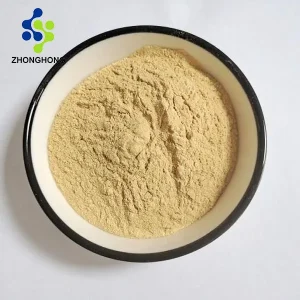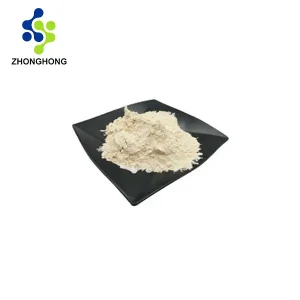Probiotic-Fermented Botanicals: Nature’s Bioenhanced Powerhouse
1. What Are Probiotic-Fermented Botanicals?
Probiotic-fermented botanicals represent a cutting-edge fusion of traditional herbal knowledge and modern biotechnology. They involve the controlled fermentation of specific medicinal or functional plants (botanicals) using carefully selected strains of beneficial bacteria or yeast (probiotics). This biotransformation process significantly alters the plant’s chemical profile, enhancing the bioavailability and potency of bioactive compounds, generating novel metabolites, reducing potential anti-nutrients, and improving sensory properties. The result is a unique class of nutraceutical ingredients offering superior health benefits compared to their non-fermented counterparts.
2. Product Source, Chemical Nature, & Identification
-
Tinubdan: Premium, sustainably sourced raw botanical materials (e.g., herbs, roots, fruits, mushrooms). Specific sources vary by product (e.g., fermented Turmeric, Ginger, Ginseng, Reishi, Astragalus, Green Tea).
-
Kinaiya sa Kemikal: Complex mixtures containing:
-
Original Bioactives (Enhanced): Flavonoids (e.g., Apigenin, Luteolin), polyphenols (e.g., Curcuminoids – enhanced solubility), terpenoids (e.g., Ginsenosides – transformed profiles), alkaloids, polysaccharides (partially hydrolyzed).
-
Novel Metabolites: Unique compounds produced lamang during fermentation (e.g., specific small peptides, organic acids like lactic/acetic acid, bioactive derivatives like ginsenoside CK from protopanaxadiol-type ginsenosides).
-
Probiotic Metabolites: Postbiotics like bacteriocins, enzymes, short-chain fatty acids (SCFAs – if fermentation occurs in situ).
-
Carrier/Matrix: Residual plant fibers, fermentation media components.
-
-
Identification:
-
CAS: Varies significantly depending on the specific botanical starting material and fermentation process. No single CAS applies. (e.g., Fermented Turmeric Extract might relate to CAS 8024-37-1, but the profile is distinct).
-
MF (Molecular Formula): Not applicable to complex mixtures; defined for specific isolated compounds within the extract.
-
MW (Molecular Weight): Not applicable to complex mixtures; defined per specific compound.
-
EINECS: Varies per specific botanical source and final product specification.
-
3. Identifying the “Best” Probiotic-Fermented Botanical Product
The “best” product is highly application and goal-specific. Key evaluation criteria include:
-
Panguna nga mga sangkap:
-
Botanical Source: Clearly identified genus, species, plant part (e.g., Panax ginseng C.A. Mey root).
-
Probiotic Strains: Scientifically identified strains (Genus, Species, Strain ID – e.g., Lactobacillus rhamnosus GG) with proven safety and efficacy for fermentation.
-
Standardisasyon: Defined to key active markers (e.g., “Standardized to 20% Total Bio-Transformed Ginsenosides”). HPLC or UPLC verification is standard.
-
-
Kaepektibo ug Pagsunod:
-
Validated Benefits: Supported by sa vitro, sa vivo, and ideally human clinical studies specific to the fermented product.
-
Pagsunod sa Regulasyon: Meets relevant regulations (FDA GRAS, EU Novel Food where applicable, cGMP for manufacturing, FSSC 22000 / ISO 22000 for food safety). Claims must be substantiated and compliant with target market regulations (e.g., structure/function claims in US under DSHEA).
-
-
Sinugdanan: Traceable sourcing, sustainable practices. Region-specific benefits (e.g., Korean Ginseng, Indian Turmeric).
-
Paggamit: Varies (dietary supplements: capsules, powders; functional foods/beverages: as an ingredient). Typical dosage range: 500mg – 2000mg per day, depending on botanical, standardization, and intended effect. Always follow specific product label instructions.
-
Target nga mamiminaw: Adults seeking enhanced bioavailability, gut health support, immune modulation, reduced inflammation, cognitive support, antioxidant defense, energy metabolism support. Often favored by those with digestive sensitivities to raw botanicals.
-
Crucial Precautions:
-
Pagkonsulta sa usa ka Doktor: Especially if pregnant, breastfeeding, immunocompromised, taking medications (potential interactions), or have underlying health conditions.
-
Ang kalidad mao ang labing hinungdanon: Choose reputable suppliers with stringent QC (like Shaanxi Zhonghong).
-
Start Low: Begin with lower doses to assess tolerance.
-
Mga epekto: Generally well-tolerated. Rare, mild effects may include transient digestive discomfort (bloating, gas) as the microbiome adjusts, especially in sensitive individuals. Allergic reactions to the underlying botanical are possible.
-
-
Health Benefits & Mechanism:
-
Enhanced Bioavailability & Absorption: Fermentation breaks down complex plant structures and glycosides, freeing aglycones and smaller molecules more readily absorbed in the gut.
-
Gut Microbiome Modulation: Probiotic metabolites (postbiotics) and fermented compounds act as prebiotics, supporting beneficial gut bacteria growth and diversity.
-
Potentiated Anti-Inflammatory & Antioxidant Effects: Increased levels and activity of bioactive compounds (e.g., enhanced curcuminoid solubility, transformed ginsenosides like CK/Rg3 with higher activity) combat oxidative stress and inflammatory pathways (e.g., NF-κB inhibition).
-
Suporta sa Immune System: Modulation of gut-associated lymphoid tissue (GALT), enhanced macrophage activity, cytokine balance regulation.
-
Metabolic Health: Some fermented botanicals show improved effects on glucose metabolism and lipid profiles.
-
Neuroprotection: Potential gut-brain axis modulation via SCFAs and reduced systemic inflammation.
-
4. Manufacturer Profile: Shaanxi Zhonghong Investment Technology Co., Ltd.
Shaanxi Zhonghong is a leading high-tech nga negosyo (founded 1996) vertically integrated across R&D, collaborative innovation, integrated manufacturing, and global marketing. Specializing in advanced extraction, separation, and purification of bioactive compounds from botanicals, they serve the chemical, material science, and life science sectors.
-
Kinauyokan nga Eksperto: Natural plant extraction (including specialized fermentation), cosmetic actives, nutraceutical/functional food ingredients (dietary supplements, food/beverage additives, natural sweeteners/colors), pharmaceutical intermediates.
-
Scientific Edge (R&D Prowess):
-
Academic Collaboration: Estratehikong pakigtambayayong sa 5 top-tier universities, operating joint research laboratories.
-
IP Portfolio: Nagkupot 20+ patente covering novel extraction, fermentation, and purification methodologies.
-
Exclusive Compound Library: Maintains a proprietary global library of rare and unique phytochemicals.
-
-
Kaayohan sa Paggama:
-
Katapusan nga Analytics: Naggamit HPLC (High-Performance Liquid Chromatography), UPLC (Ultra-Performance LC), GC-MS (Gas Chromatography-Mass Spectrometry), ug NMR (Nuclear Magnetic Resonance Spectroscopy) for unparalleled identification and quantification. Enforces mga sumbanan sa kaputli nga labaw sa mga lagda sa industriya sa 20%+.
-
Fermentation Capabilities: State-of-the-art controlled bioreactors for optimized probiotic fermentation of botanicals.
-
-
Kinatibuk-ang Pag-abot: Extensive distribution network supplying gipahiangay nga mga solusyon sa sangkap to multinational pharmaceutical companies, research institutions, and manufacturers across 80+ ka nasod sa Asia, Europe, ug sa Amerika.
-
Kabilin: 28 ka tuig of deep expertise in sourcing, processing, and delivering high-purity bioactive compounds.
5. Product Specification & Quality Control (COA – Certificate of Analysis)
Shaanxi Zhonghong guarantees quality and safety through rigorous testing per international standards (USP, EP, JP, CP). A typical COA includes:
Table: Comprehensive COA Parameters for Probiotic-Fermented Botanicals
| Kategorya | Parameter | Specification/Indicator | Pamaagi sa Pagsulay |
|---|---|---|---|
| Mga pestisidyo | Mga chlorpyrifos | ≤ 0.01 ppm | GC-MS/MS, LC-MS/MS |
| Cypermethrin | ≤ 0.05 ppm | GC-MS/MS, LC-MS/MS | |
| Glyphosate | ≤ 0.05 ppm | LC-MS/MS | |
| Total Others (Sum) | ≤ 0.5 ppm | Multi-Residue Methods (e.g., QuEChERS) | |
| Bug-at nga Metal | Tingga (Pb) | ≤ 3.0 ppm | ICP-MS, AAS |
| Arsenic (As) | ≤ 2.0 ppm | ICP-MS, HG-AAS | |
| Cadmium (Cd) | ≤ 1.0 ppm | ICP-MS, GF-AAS | |
| Mercury (Hg) | ≤ 0.1 ppm | CV-AAS, ICP-MS | |
| Microbiology | Kinatibuk-ang Ihap sa Plate | ≤ 1000 CFU/g | USP <61>, EP 2.6.12 |
| Lebadura ug agup-op | ≤ 100 CFU/g | USP <61>, EP 2.6.12 | |
| E. coli | Negative in 1g / 10g | USP <62>, ISO 16649 | |
| Salmonella spp. | Negative in 10g / 25g | USP <62>, ISO 6579 | |
| Staphylococcus aureus | Negatibo sa 1g | USP <62> | |
| Listeria monocytogenes | Negative in 25g | USP <62>, ISO 11290 | |
| Ang uban | Nabilin nga mga Solvent | Complies with ICH Q3C / USP <467> | GC-FID, GC-MS |
| Aflatoxins (B1, B2, G1, G2) | ≤ 5 ppb (Total), ≤ 2 ppb (B1) | HPLC-FLD, LC-MS/MS | |
| Identity (Botanical) | Conforms (HPLC/UPLC Fingerprint, TLC, NMR) | Pharmacopoeial Standards | |
| Assay (Active Markers) | ≥ XX% (e.g., Total Polyphenols, Specific Saponins) | HPLC, UV-Vis, Gravimetric | |
| Panagway | Fine Powder, Characteristic Color & Odor | Visual, Organoleptic | |
| Pagkawala sa Pagpauga (LOD) | ≤ 5.0% | USP <731> | |
| Ash | ≤ 5.0% | USP <281> |
6. Production Process Overview
-
Pagkuha sa Hilaw nga Materyal ug QC: Strict selection of premium, identity-verified botanicals. Initial testing for contaminants.
-
Pre-Treatment: Cleaning, drying, milling to optimal particle size.
-
Probiotic Strain Activation & Inoculum Prep: Selected strains cultured and scaled to optimal density.
-
Controlled Fermentation: Botanical substrate combined with probiotics in specialized bioreactors under precisely controlled conditions (temperature, pH, anaerobic/aerobic, duration – often 24-72 hours). Monitoring key metabolites.
-
Fermentation Termination: Halting process at peak bioactive profile.
-
Post-Fermentation Processing: Separation (filtration, centrifugation), extraction (if needed – e.g., solvent, supercritical CO2), concentration.
-
Pagpauga: Spray drying or freeze-drying (lyophilization) to create stable powder.
-
Standardization & Blending: Adjusting to specified active marker levels.
-
Hugot nga Pagsulay sa QC: Full COA battery (as above) on every batch.
-
Pagputos: Food-grade, moisture-resistant containers under controlled environment.
7. Mga Sitwasyon sa Paggamit
-
Mga suplemento sa pagkaon: Capsules, tablets, softgels, powders (single-ingredient or blends).
-
Functional Foods: Fortified bars, cereals, yogurts, snacks.
-
Beverages: Enhanced juices, smoothies, kombucha, functional waters, shots.
-
Mga kosmetiko: Serums, creams, masks targeting anti-aging, inflammation, skin barrier support.
-
Nutrisyon sa Hayop: Pet supplements, livestock health enhancers.
8. Pagkontrol sa Kalidad
Shaanxi Zhonghong’s Quality Management System (QMS), aligned with cGMP (current Good Manufacturing Practices), ISO 9001, ug FSSC 22000 / ISO 22000, is the cornerstone of product integrity. Quality by Design (QbD) principles guide process development. Stringent Supplier Qualification ensures traceable, contaminant-screened raw botanicals. In-process controls (IPC) meticulously monitor critical parameters (pH, temperature, biomass, key metabolites via HPLC/UPLC) throughout fermentation and downstream processing. Mga Pagtuon sa Kalig-on (ICH guidelines) determine shelf life and optimal storage conditions. The cornerstone is batch-specific COA verification against exhaustive specifications (Pesticides, Heavy Metals, Microbes, Residual Solvents, Aflatoxins, Identity, Potency, Purity) using state-of-the-art instrumentation (HPLC, UPLC, GC-MS, ICP-MS, NMR). Method validation per ICH Q2(R1) ensures accuracy, precision, specificity, and robustness. Strict environmental monitoring ug hygiene protocols prevent cross-contamination. Comprehensive documentation ug electronic data integrity ensure full traceability from raw material to finished product. Regular audits and continuous improvement programs maintain the highest quality benchmarks, delivering consistent, safe, and efficacious probiotic-fermented botanicals globally.
9. Packaging & Logistics
-
Pagputos: Standard: Double-layer sealed food-grade polyethylene (PE) bags inside fiber drums (25kg net). Custom options: Aluminum foil bags (1kg, 5kg), vacuum-sealed bags. Complies with international transport regulations. Labels include full traceability data (Batch No., MFG/EXP Date), specifications, and safety info.
-
Pagtipig: Store in a cool (<25°C), dry place, away from direct sunlight. Maintain original sealed packaging.
-
Logistics: Efficient global shipping via air or sea freight. Expertise in handling customs clearance and documentation (Certificate of Origin, Commercial Invoice, Packing List, COA). Hazardous goods declaration not typically required. Cold chain available upon request for sensitive materials.
10. Health Efficacy & Mechanisms, Innovation & Challenges
-
Mekanismo nga Deep Dive: Research focuses on how fermentation modifies gut microbiota composition/diversity, enhances intestinal barrier integrity (tight junction proteins), modulates immune cell signaling (dendritic cells, T-cells), influences epigenetic regulation, and produces bioactive metabolites (like equol from daidzein, specific ginsenosides) with higher receptor affinity (e.g., PPARγ, Nrf2, NF-κB).
-
Industry Applications: Rapid growth in personalized nutrition (targeted formulations), synergistic blends, delivery system innovation (encapsulation for targeted release), and integration into diverse food matrices without compromising taste.
-
Cutting-Edge Research: Exploring the gut-brain axis impact (mood, cognition), metabolic syndrome management (NAFLD, insulin resistance), specific immunomodulation (allergies, autoimmunity), and application in precision oncology support (adjuvant therapy). Metabolomics and microbiome sequencing are key tools.
-
Key Challenges: Standardizing complex fermented mixtures, definitive human clinical trials for each fermented botanical, regulatory clarity (novel food status variations), scaling fermentation while maintaining consistency, cost-effective production, and consumer education on differentiating quality.
11. FAQ (Frequently Asked Questions)
-
Q: Are probiotic-fermented botanicals the same as probiotics?
A: No. While they use probiotics in production, the final product primarily contains the fermented botanical material and its metabolites (postbiotics), not necessarily live probiotics (unless added back). -
Q: Why choose fermented over standard extracts?
A: Key benefits include significantly enhanced bioavailability of actives, generation of unique beneficial metabolites, reduced potential for digestive irritation, and often improved taste/odor. -
Q: Naa bay side effects?
A: Generally very safe. Mild, temporary digestive upset (gas, bloating) is the most common, typically resolving as the body adjusts. Allergies to the base botanical are possible. -
Q: How long until I see benefits?
A: Varies greatly by individual, health goal, and product. Some notice subtle changes (digestion, energy) within days/weeks; systemic benefits (immunity, inflammation) may take consistent use over 1-3 months. -
Q: Is this product FDA-approved?
A: Dietary ingredients (like most botanical extracts) are not “approved” by the FDA like drugs. Shaanxi Zhonghong manufactures in cGMP-compliant facilities, and ingredients are GRAS (Generally Recognized As Safe) or compliant with DSHEA for dietary supplements. Final product compliance is the brand’s responsibility. -
Q: Can I take these while pregnant/breastfeeding or on medication?
A: Always consult your healthcare provider first. Safety data can be limited for specific fermented botanicals in these populations, and interactions with medications are possible. -
Q: Where can I buy Shaanxi Zhonghong’s ingredients?
A: Contact their global sales team for purchasing inquiries and distributor information.
12. Where to Buy & Request Samples
Interested in formulating with high-quality, research-backed probiotic-fermented botanicals?
-
Bisitaha ang among website: Explore our portfolio at aiherba.com
-
Contact Sales: Email: liaodaohai@gmail.com
-
Pagpangayo og Libre nga mga Sampol: Contact us via email to discuss your project needs and request complimentary samples for evaluation. Specify the botanical of interest.
13. Panapos
Probiotic-fermented botanicals represent a transformative advancement in natural product science. By harnessing the power of beneficial microbes, Shaanxi Zhonghong unlocks the enhanced bioactivity and unique health potential inherent in plants. Their commitment to cutting-edge R&D, rigorous quality control exceeding industry standards, and 28 years of bioactive compound expertise make them the premier partner for sourcing premium, efficacious, and safe fermented botanical ingredients for the global nutraceutical, functional food, and cosmeceutical markets. Experience the bio-enhanced difference – contact Shaanxi Zhonghong today.
14. Mga pakisayran
(Note: Specific references would be added based on claims and product specifics)
-
[Relevant review on biotransformation of botanicals via fermentation – e.g., Journal of Agricultural and Food Chemistry]
-
[Clinical study on specific fermented botanical efficacy – e.g., specific to Turmeric/Ginseng]
-
[Paper on bioavailability enhancement via fermentation – e.g., Phytomedicine]
-
[US FDA GRAS Notices (if applicable)]
-
[European Food Safety Authority (EFSA) Scientific Opinions (if applicable)]
-
[USP/EP/JP Monographs for Botanical Identification & Testing]
-
ICH Quality Guidelines (Q2(R1), Q3C, Q1A(R2)).
-
Shaanxi Zhonghong Internal Research & Technical Dossiers.






评价
目前还没有评价